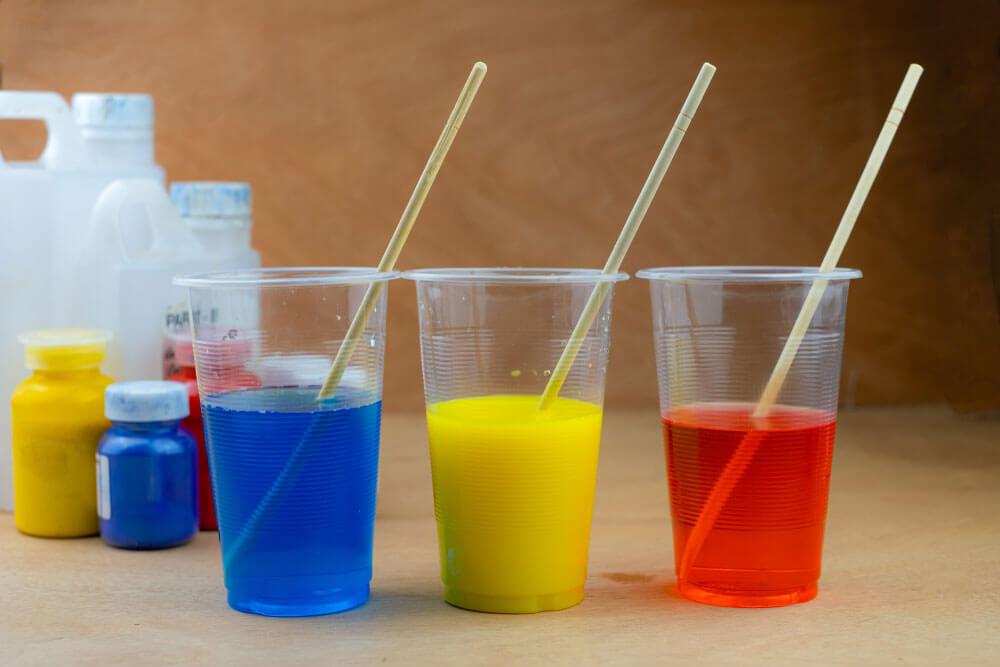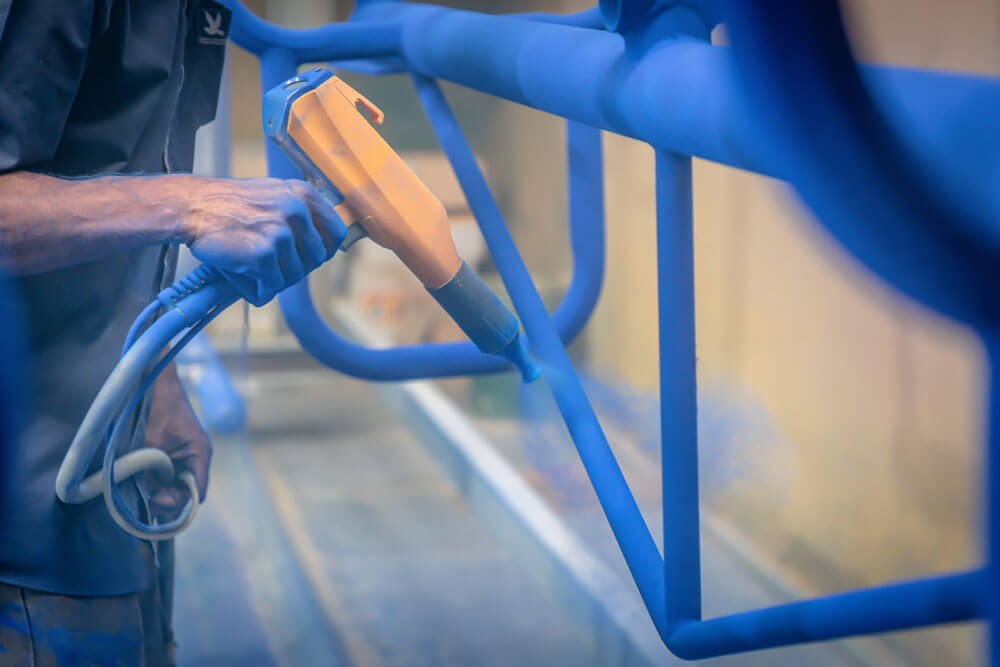What Is Powder Coating?
Since the 1940s, when it emerged as an application method of electrostatically coating items and curing them with heat, powder coating services have been increasing in demand worldwide.
What sets powder coating apart from conventional paint is its durability, flexibility, and abrasion resistance, resulting in custom parts with a tougher, harder finish. Powder coating is mainly applied to industrial equipment, however, it can be used on a variety of surfaces and household appliances including, aluminum, concrete, and powder coated steel. In addition, powder coating can be used for powder coating wheels and automotive parts.
Today, a multitude of powder coating colors and textures are available, offering various options and superb performance. With an uncompromising quality at an affordable rate, it’s no surprise why it is an excellent finishing option for both indoor and outdoor use.
How It works
The most common powder application method includes combining ingredients including polymer resin systems, leveling solutions, and pigments, which are melted and ground into a fine powder through an electrostatic process. This dry powder is then cured with heat. Electrostatic spray deposition (ESD) is commonly used to adhere the powder coating onto a metal surface, using a spray gun. The role of the spray gun is to electrostatically charge the powder particles. Next, heat is applied to items by placing them into a powder coating oven. This results in a top-quality finish, providing both aesthetic appeal and functionality.
Electrostatic fluidized bed coating is another powder coating method where a hot item is immersed into a powder bed, enabling the powder to melt onto the item, resulting in a thin layer that flows across and continuously coats the surface. Regardless of the application process employed, powder coatings are durable, long-lasting, easy to apply, cost-efficient, and environmentally beneficial.
Powder Coating Types
Powder coatings are available in various types and are selected depending on specific environmental needs. Powder coating is a superb finishing solution since it is environmentally friendly and limits environmental waste. When deciding on a powder coating finish, it is important to consider what type of service you are seeking to obtain the best outcome. Popular powder coating choices include polyester powder coatings, epoxy resin powder coatings, and hybrid powder coatings.
Polyester Urethane Powder Coating
Often seen in plumbing and automotive industries, the most popular powder coating applications known for providing excellent durability and resistance are TGIC polyester and polyester urethane. Although polyester urethane powder provides excellent performance and results in a tough long-lasting product, it may not be the ideal powder coating choice for companies that manufacture low-cure products including cast, lead-based parts, and aluminum. This is due to polyester urethane requiring higher curing temperatures. They are also known to produce an “orange peel” effect due to increased thickness since they are designed for thin-film applications.
TGIC Polyester Powder Coating
Automotive and power transmission industries often turn to TGIC polyester powders as their coating solution. TGIC polyester powders can be sprayed at a greater thickness than polyester urethane and can be cured at lower temperatures, making them an excellent choice for low-cure products like cast and aluminum parts. Though they are not reputable for having high chemical resistance, TGIC polyester powders are also very durable.
Epoxy Powder Coating
Epoxy powder coating is among the first powder coating services used since powder coating became commercially available and is a popular coating choice, providing wearability, corrosion protection, and chemical resistance. It is no surprise why many companies rely on epoxy coating for their products. Epoxy powder coating is used by automotive, oil & gas, and medical industries, providing superb performance and toughness. Keep in mind that epoxy powder coatings are ideal for indoor environments since exposure to UV rays can impact their longevity.

Epoxy-Polyester (Hybrid) Powder Coating
With many of the same features as Epoxy powder coating, hybrid powder coatings offer superb corrosion protection, although they are not the best choice for outdoor environments since exposure to UV rays can impact their duration. These powder coating applications are commonly seen in plumbing and electronic industries.
Eco-Friendly Benefits of Powder Coating
Solvent-based liquid paints contain high levels of vaporous organic compounds (VOCs) and contribute to environmental and chemical pollution. There is a growing demand for environmentally conscious initiatives to lessen our carbon footprint and reverse the consequence of polluting our planet. Powder coating is free of volatile organic compounds (VOCs) and does not emit gases. Air quality is not a concern since it contains no hazardous air pollutants (HAPs). Green initiatives provide innovative solutions to assuring a safer future for generations to come.
Low Carbon Footprint
Powder coating consumes less fuel since it is not liquid-based, allowing for larger volumes to be transported by using less material, a win-win in terms of providing efficacy, reducing costs, and minimizing resources. This is certainly an eco-friendly outcome. Fewer resources used in powder coating consume less energy, resulting in less landfill waste, and ultimately a drastically lower carbon footprint than solvent-based coatings.
Excess Powder Can Be Recycled
Rather than disposing of it as waste, a powder coating company can recycle or reuse the powder which is leftover following the process, saving money and the resources required to produce more powder. Companies that use liquid coating cannot recycle paint drips. Many companies today are turning to eco-friendly solutions given their numerous environmental benefits.
Longevity
The durability of a powder coating finish assures that it can last a long time.Being exceptionally tough and strong, it is unparalleled in withstanding erosion, weather changes, moisture content, and UV exposure. This minimizes the risk of corrosion, scratches, and abrasions, resulting in a long-lasting product. The application process is precise and evenly applied, resulting in a functional and efficient product that eliminates mistakes such as an uneven coating.
To determine product longevity, several factors are taken into consideration including the environment the product is exposed to, the quality of preparation, and lastly, the type of powder coating used. Wear and tear, UV light exposure, and exposure to an outdoor environment may impact longevity, though powder coating finishes are known to last for well over a decade. The type of coating used also plays a role in endurance. Epoxy coatings can last for years indoors but deteriorate a lot faster when exposed to an outdoor environment compared to fluoropolymer and urethane-based coatings.
Benefits of Powder Coating
It is no surprise why powder coatings are a popular choice for many companies since there are many advantages to selecting powder coating solutions. They are known for their toughness and durability, which makes them a dependable choice for customers seeking a long-lasting high performing finishing product.

Eco-friendly
Being both reusable and recyclable, powder coatings produce minimal waste compared to liquid-based paint, which often results in overspray and drips that cannot be recycled, contributing to waste and presenting environmental hazards. Powder coatings do not require solvents like liquid-based paints, which contain VOCs. Solvents evaporate and consequentially release toxins into the atmosphere, impacting our air quality. Staff who work with VOCs may be exposed to soft tissue and nervous system damage due to inhaling solvents. Overall, powder coatings are a much safer choice and pose a lesser health threat compared to alternative finishes.
Cost-effective
Although it may initially appear that powder coating finishes are costly, they are more affordable than other finishing types. This is due to product longevity and lesser touch-ups and lowered product waste.
Performance
Powder coated parts are highly resistant to wear and tear and scratching, chipping, and fading, assuring a high-quality product that looks aesthetically appealing while providing excellent functionality and longevity.
Are There Any Disadvantages to Powder Coating?
Although powder coating provides numerous advantages and is a popular finishing solution for many industries, it is not without some disadvantages.
Color Accuracy
During the process of recycling and reusing, cross-contamination could occur, resulting in colors that may not appear exactly as desired. This could result in touch-ups appearing slightly different, however, there is a solution to this. Powders that are not being used need to be packaged to prevent slight color variations.
Coating Control
Achieving the desired level of thickness and controlling coating thickness during the application process may prove to be a difficult feat. This could potentially affect the texture by creating uneven layers, with thickness varying throughout the coating. In these instances, the powder coating process may need to be redone.
Is Powder Coating the Superior Finishing Option?
If you are looking for an attractive finish that offers top quality and high performance, then powder coating is second to none. In addition to being more resistant than liquid-based paint, powder coating is also an eco-friendly solution and a conscious decision to protect our environment.